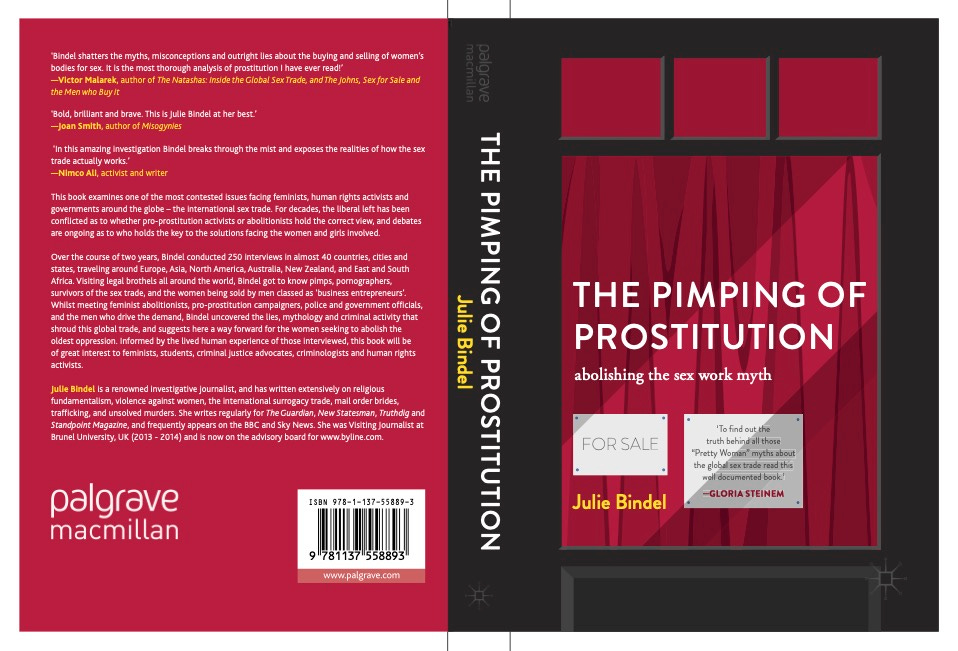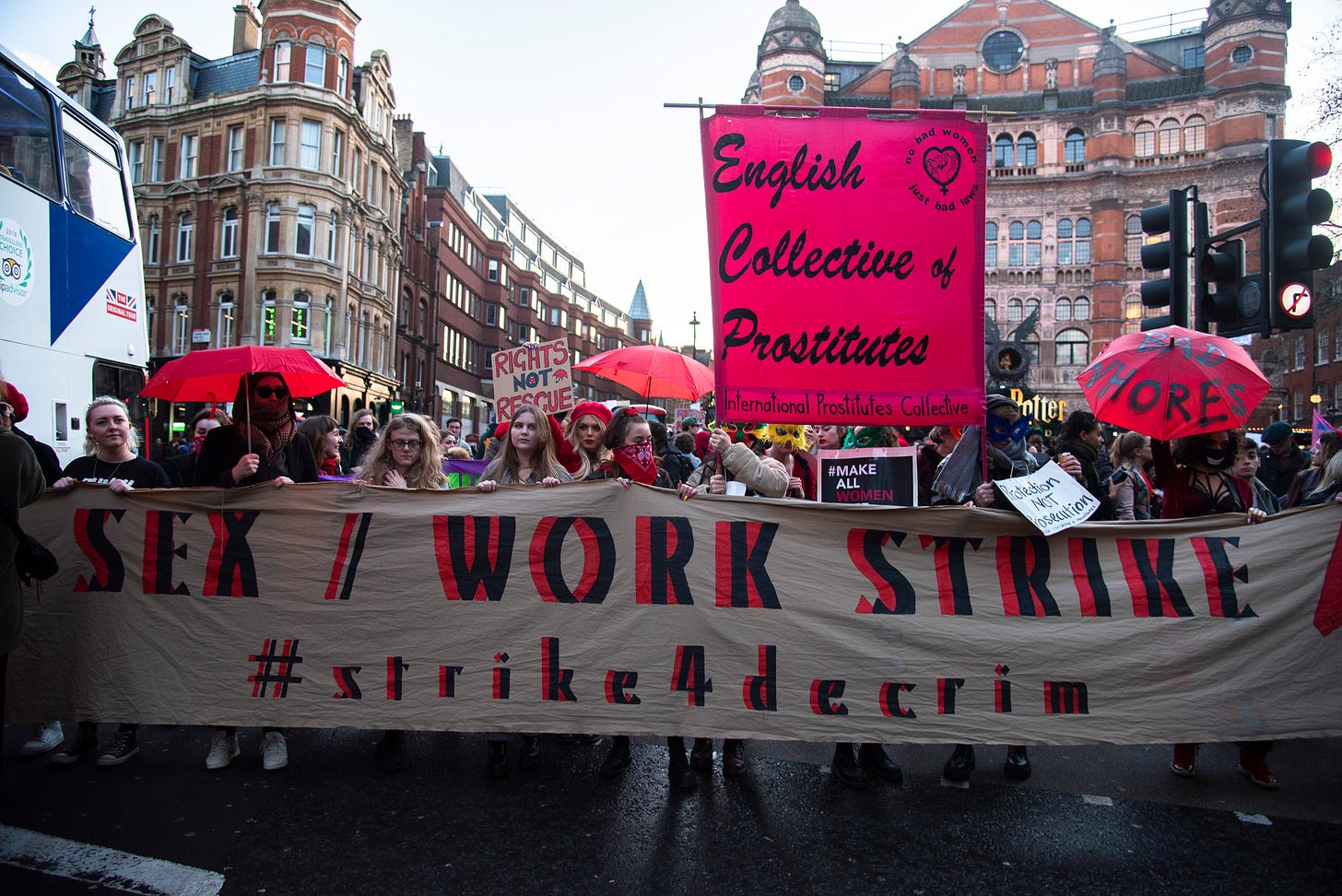The Pimping of Prostitution:
Description
The preface from my book, The Pimping of Prostitution: Abolishing the Sex Work Myth (Palgrave, 2017). Republished here because the same arguments about ‘choice’ and ‘work’ are still being trotted out by politicians and ‘human rights’ idiots
“With or without external supporters I have three million sex workers behind me.”
(Irena Maslova, leader of the ‘sex worker movement’ Silver Rose, Russia, 2015)
“I don’t foresee a situation where there will be no sex workers – in Kenya, in Africa, in the world – because there is demand for it. Sex is a human right, whether it’s free or there’s monetary considerations.”
(Penina Mwangi, Executive Director, Bar Hostess Empowerment and Support Programme, Kenya, 2015).
The contemporary ‘sex worker’s rights’ movement is made up of a number of perspectives and positions, but the various strands have one core view in common: a passionate dislike of any legal or State intervention. This is a shift from the 1980s and ‘90s, when the movement was united in supporting legalisation, such as the Dutch and German models. Today, most Sex Workers’ Rights Activists (SWRAs) oppose legalisation, with the exception of a number of activists in Germany, the Netherlands and Nevada. But even in those areas, where the off-street sex trade is fully legalised, the system is staunchly criticised by those who wish to see an end to any regulation at all. Therefore, New Zealand, which has fully decriminalised all aspects of the sex trade has become the preferred model.
Supporters of legalisation often cite the Netherlands as a shining example. For a number of years, beginning immediately after the sex trade was legalised there in 2000, delegations were brought from Netherlands to Europe to sell the model. More recently, and especially since decriminalisation was introduced in New Zealand in 2003, the SWRAs are unlikely to admit that their side of the political fence ever supported legalisation and criticise it for being over-regulated.
Since its inception, the ‘sex workers’ rights’ movement has been successful in identifying key issues and problems faced by women in prostitution, such as police violence and harassment, and social stigma. The early days of the movement was led by socialist women who had a class, rather than gendered, analysis of prostitution, but who genuinely fought for better ‘working’ conditions and rights for the most disenfranchised women in the sex trade.
The History
The term ‘sex work’ was coined in the early 1980s by Carol Leigh and was popularised by a 1987 anthology of the same name.
As she describes in The Prostitution Papers , the feminist icon Kate Millett was at a 1971 women’s liberation movement conference at which some SWRAs became very angry with the feminists there. They became particularly enraged when a panel entitled ‘Towards the Elimination of Prostitution‘ was organised including ’everyone but prostitutes’. Things rapidly degenerated into chaos. Prostitutes had gathered their still-nebulous rage against their own lives and redirected it towards the movement of women who appeared to be summarily “eliminating” prostitution: aka the means of their livelihood. The argument became so heated that a physical fight broke out.
In the mid 1970s, Helen Buckingham promoted herself as the main spokesperson for women in the sex trade in Britain. Buckingham described herself as a “high priced escort” and claimed to have a number of regular, wealthy punters. In 1975 Buckingham was declared bankrupt by the Inland Revenue, which demanded tax from her earnings in prostitution. Buckingham argued that if she was required to pay tax, she must be allowed to work legally. Buckingham founded a group PUSSI (Prostitutes United for Social Integration) which later changed to PLAN (Prostitution Laws are Non-sense) and allied herself to Selma James, founder of the International Wages for Housework Campaign, which demands money from the Government for women’s unwaged work in the home. Together they founded the English Collective of Prostitutes (ECP) in 1975.
In the early days, the ECP were abolitionists. The aims and objectives of James and her colleagues were clear: women should be paid for all labour, including housework and sex. “For prostitutes, against prostitution”, was its mantra. The ECP positioned itself as part of the working class movement for more money and less work. They referred to the introduction of the kerb crawling law as ‘the new suss law’ (‘suss’ is the abbreviation for a stop and search law in England and Wales that permitted a police officer to stop, search and potentially arrest people on suspicion of having committed a crime).
Meanwhile, the prostitutes’ rights movement in Europe was launched in Lyon, France, in 1975, when French prostitutes occupied a church in protest at the way in which they were treated by the police. The strike protested against the savage police repression and corruption in Lyon, which had been experiencing a wave of brutal murders of prostitutes.
Margaret Valentino and Mavis Johnson of the ECP provide an introduction to the volume of life stories of French women involved in the strike, and an analysis setting out the ECP position. They explained that: “Prostitution was one way women had been fighting to get paid for housework - by getting paid for all the sexual services all women are always expected to give for free” . The cause of prostitution was “poverty and women’s refusal of poverty”, and “the end of women’s poverty is the end of prostitution”. The ECP approach was abolitionist rather than celebratory. Rather than arguing that ‘sex work’ is empowering or even enjoyable, the ECP saw it as exploitation, the same as they did for all labour under capitalism.
COYOTE was founded in the US out of WHO (Whores, Housewives and Others) in 1973 by Margo St James, who described herself as an ex-prostitute. St James was given money by the Point Foundation at Glide Memorial Church, San Francisco, and later $1,000 dollars from the Playboy Foundation. St James recruited 50 high-profile individuals to form the COYOTE advisory board, as well as prostituted women to campaign for decriminalisation. Interested parties, including students, sex buyers, politician







